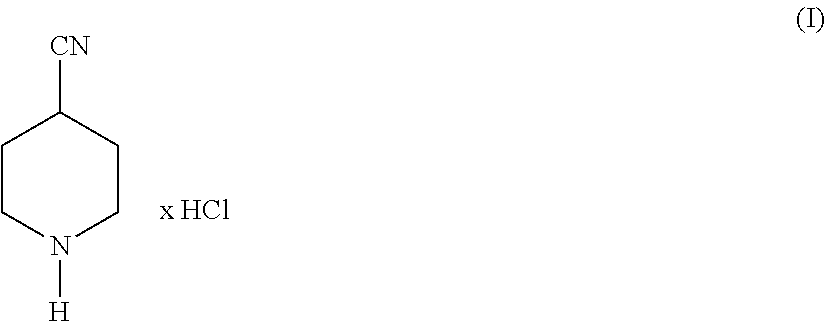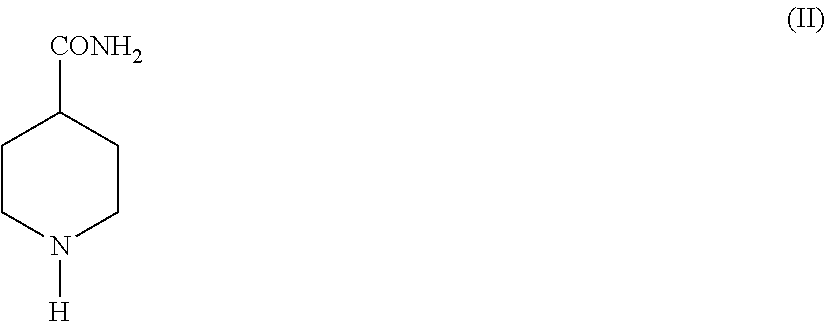Method for preparing 4-cyanopiperidine hydrochloride
a technology of cyanopiperidine and hydrochloride, which is applied in the field of new methods, can solve the problems of laborious extraction of products using volatile solvents, poor yield, and low yield, and achieves the effects of simple isolation, economical and ecological, and simple operation
- Summary
- Abstract
- Description
- Claims
- Application Information
AI Technical Summary
Benefits of technology
Problems solved by technology
Method used
Image
Examples
example 1
[0042]11.9 g [75.7 mmol] of dibutylformamide (99%) were added to a suspension of 10 g [75.7 mmol] of isonipecotamide (97%) in 50 ml of n-propyl acetate at 20° C. over 5 minutes. After 5 minutes, the addition of 18.91 g [158.9 mmol] of thionyl chloride at 20° C. was initiated. This addition required 45 minutes in which the temperature was maintained constantly at 20° C. After the end of the addition, the mixture was stirred at 20° C. for a further 18 hours. The suspension was filtered and the filter residue was washed with n-propyl acetate. After drying there remained 8.55 g of a colourless solid. Analysis by quantitative NMR spectroscopy gave a 4-cyanopiperidine hydrochloride content of 95% (w / w). A yield of 73% of theory is calculated therefrom.
[0043]Chloride content by ion chromatography (IC): 26.4% (calc.: 24.8%).
[0044]1H-NMR (600 MHz, d6-DMSO): δ=1.91-2.13 (m, 2H), 2.08-2.13 (m, 2H), 2.97-3.00 (m, 2H), 3.12-3.2 (m, 3H), 9.27 (s, br, 2H) ppm.
example 2
[0045]In a 1 liter jacketed vessel, 111.56 g [0.702 mol] of dibutylformamide (99%) were added to a suspension of 92.8 g [0.702 mol] of isonipecotamide (97%) in 450 ml of n-propyl acetate at 20° C. over 10 minutes. After 5 minutes, the addition of 175.46 g [1.475 mol] of thionyl chloride at 20° C. was initiated. This addition required 60 minutes in which the temperature was maintained constantly at 20° C. After the end of the addition, the mixture was stirred at 20° C. for a further 18 hours. The suspension was released from the reactor and filtered. The filter cake was washed three times each with 150 ml of n-propyl acetate and then dried. 83.07 g of a colourless solid were obtained. Analysis by GC against a reference standard following silylation gave a 4-cyanopiperidine hydrochloride content of 98.1% (w / w). A yield of 79.1% of theory is calculated therefrom.
example 3
[0046]In a 1 liter jacketed vessel, 111.56 g [0.702 mol] of dibutylformamide (99%) were added to a suspension of 92.8 g [0.702 mol] of isonipecotamide (97%) in 450 ml of n-propyl acetate at 20° C. over 10 minutes. After 5 minutes, the addition of 175.46 g [1.475 mol] of thionyl chloride at 20° C. was initiated. This addition required 60 minutes in which the temperature was maintained constantly at 20° C. After the end of the addition, the mixture was stirred at 20° C. for a further 18 hours. The suspension was released from the reactor and filtered. The filter cake was washed three times each with 150 ml of n-propyl acetate and then dissolved in 532 g of methanol. From the resulting 681.2 g of solution, 10 g were concentrated under vacuum from which 1.2 g of colourless solid were obtained as residue. Analysis by GC against a reference standard following silylation gave a 4-cyanopiperidine hydrochloride content of 98.5% (w / w). A yield of 78.1% of theory is calculated therefrom.
PUM
| Property | Measurement | Unit |
|---|---|---|
| water content | aaaaa | aaaaa |
| water content | aaaaa | aaaaa |
| pH | aaaaa | aaaaa |
Abstract
Description
Claims
Application Information
 Login to View More
Login to View More - R&D
- Intellectual Property
- Life Sciences
- Materials
- Tech Scout
- Unparalleled Data Quality
- Higher Quality Content
- 60% Fewer Hallucinations
Browse by: Latest US Patents, China's latest patents, Technical Efficacy Thesaurus, Application Domain, Technology Topic, Popular Technical Reports.
© 2025 PatSnap. All rights reserved.Legal|Privacy policy|Modern Slavery Act Transparency Statement|Sitemap|About US| Contact US: help@patsnap.com



